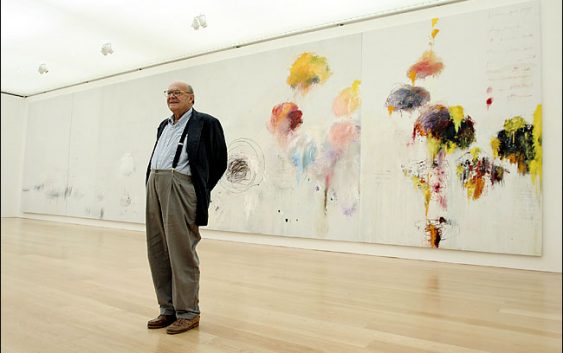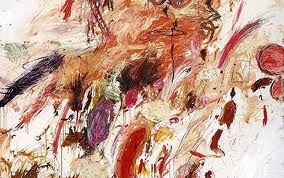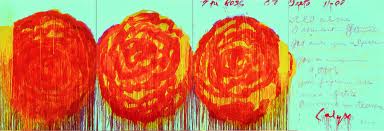Cy Twombly: Against All Odds, Rises an Artist of Greatness


Part 1: Overview and Beginnings

One of his first major exhibits was described by a critic as a fiasco, involving scribbles a grammar school student could have created. Even one of his supporters described his work as discomfiting to critics and truculently difficult for laymen. So, how did Cy Twombly, who came from relatively nondescript beginnings, attended a seemingly obscure college, lived almost incognito for many years outside Rome, and produced works of seeming collagic chaos and meaningless scrawl, somehow reach the apex of modern art? Because his creations, described by one critic as “a mix of subversive vulgarity and grand ideas”, are, in reality, both informed and purposely conformed, and this combination has somehow had a lasting cerebral, visceral, and emotional impact on generations of viewers. Indeed, it is not the subject matter of an artist’s work that counts, but what the depiction conveys to the individual observer at the instant of apprehension – basically, the gut level response one has to the piece.

Cy Twombly is not for everyone, he is an acquired taste, more appreciated by the museums than the general public. One must digest and study the scholarly essays about him and then re-study his works to realize their true worth. Influenced by those who found personal freedom by escaping from Nazi Germany, he rejects the artistic hierarchy and embraces the creative liberties he finds in abstract expressionism. He is modern, yet appreciates the old and the ancient. He is cerebral, yet much of his work is visceral. His work is seemingly unknowable, yet certainly inimitable. His work is studied, the product of intense contemplation, yet completely unpredictable. He is an American, but lives in Rome for most of his life, immersed in Mediterranean culture. Neglected in the United States for many years, he is resurrected and his works sell for millions, although throughout his entire career he had the respect and admiration of his fellow artists.
So, how exactly does a revolutionary such as Cy Twombly develop? Every experience he has shapes him and provides fodder for his work. He is born in Lexington, Virginia in 1928, not exactly an artistic hotbed. As a boy, he is introspective and an avid reader, checking out books from the library of Washington and Lee University where his father is on the staff. He is influenced by the many stately buildings in Lexington and takes private art lessons with the expatriated Spanish modern master Pierre Daura. He pursues art at many schools, studying most notably at the Art Students League in New York, where he meets future great artist Robert Rauschenberg; this meeting is of seminal importance in forging Twombly’s future life. At Rauschenberg’s behest, the two attend Black Mountain College near Asheville, North Carolina in 1951. This unlikely location turns out to be a furnace of radical creativity: Twombly meets present and future creative titans Franz Kline, Robert Motherwell, Ben Shahn, John Cage, and Merce Cunningham. Wow! Motherwell, impressed with Twombly’s budding talent, arranges his first solo exhibit in 1951 in New York. So, Cy Twombly is launched, but the road will be rocky for this revolutionary. In 1952, Twombly and Rauschenberg make a groundbreaking trip to North Africa and Europe; the influences of this trip set the course for the rest of Twombly’s life. Returning to the United States, he serves in the army as a cryptologist; one can only postulate how this work shaped the future master of the line and the inscrutable. He develops his technique of gestural drawing, which will eventually bring him notoriety, and also sculpts creations from found objects reflecting his interest in tribal and primitive art, which he acquired on his trip. In 1957, he moves to Rome, which will be his lifelong intellectual and emotional sanctum sanctorum and also the workplace for the gestation of his grand projects.

Part 2, next month, will cover his career from 1957 on and will both display and discuss some of his most significant and appealing works. In the interim, perhaps the reader will investigate the Twombly oeuvre, just to get a glimpse of the viewing surprises ahead in Part 2.

